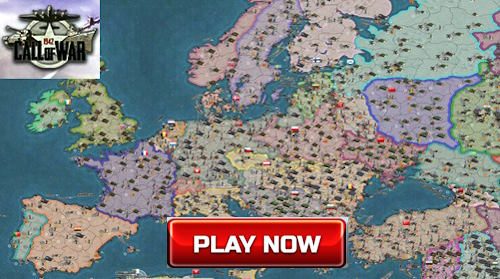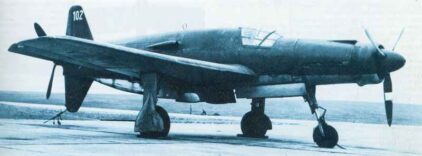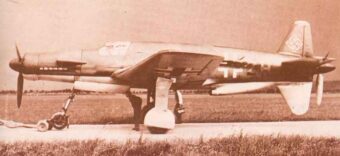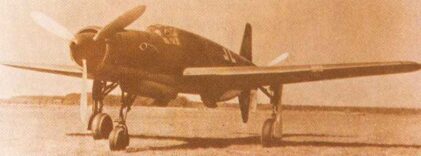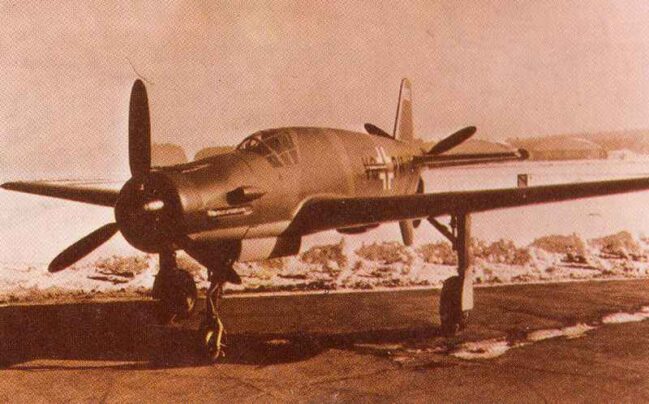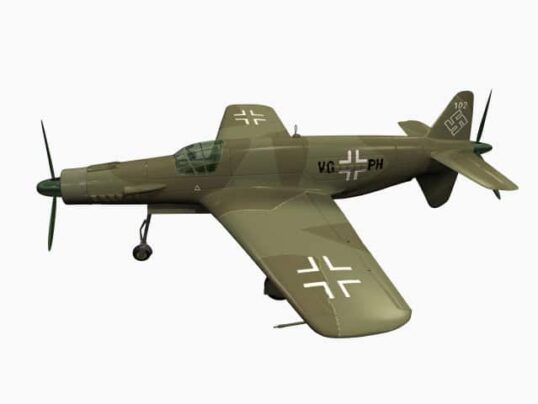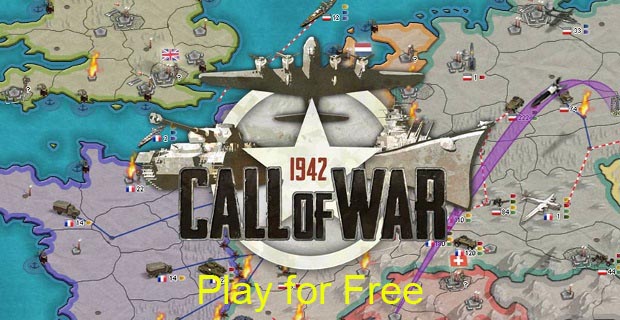Dornier Do 335 ‘Pfeil’ (Arrow) fighter-bomber of the Luftwaffe.
History, development, service, specifications, statistics, pictures and 3D-model.
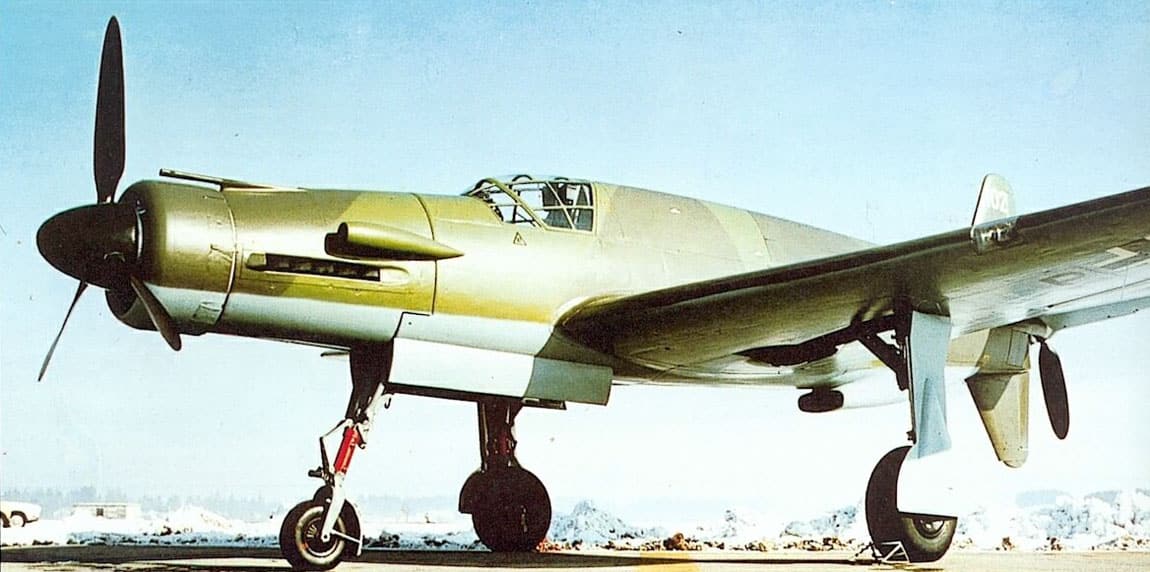
Do 335 ‘Pfeil’
Table of Contents
Dornier Do 335 Arrow (Pfeil)
Type: German fighter-bomber, long-range fighter, heavy fighter, Zerstörer (destroyer), night fighter, reconnaissance plane.
The Dornier Do 335 Pfeil (Arrow) was a unique and innovative German heavy fighter and fighter-bomber designed during World War II. It had a distinctive push-pull configuration with two engines, one in the nose and one in the rear of the fuselage, driving propellers in the front and rear.
Overview of the Do 335
Speed: The Do 335 was one of the fastest piston-engined aircraft of its time, with a top speed of around 474 mph (763 km/h).
Armament: It was heavily armed with one 30 mm cannon firing through the propeller hub and two 20 mm cannons in the nose.
Engine configuration: The push-pull layout allowed for better streamlining and reduced drag compared to conventional twin-engine designs.
Ejection seats: The Do 335 was one of the first aircraft to be fitted with ejection seats.
Variants: Several versions were planned, including a night fighter, a reconnaissance aircraft, and a two-seat trainer.
Despite its potential, the Do 335 entered service too late and in too small numbers to have a significant impact on the war. Only a handful of aircraft were built and flown before the end of the conflict. Today, one surviving Do 335 is on display at the Smithsonian National Air and Space Museum’s Udvar-Hazy Center in Chantilly, Virginia, USA.
History
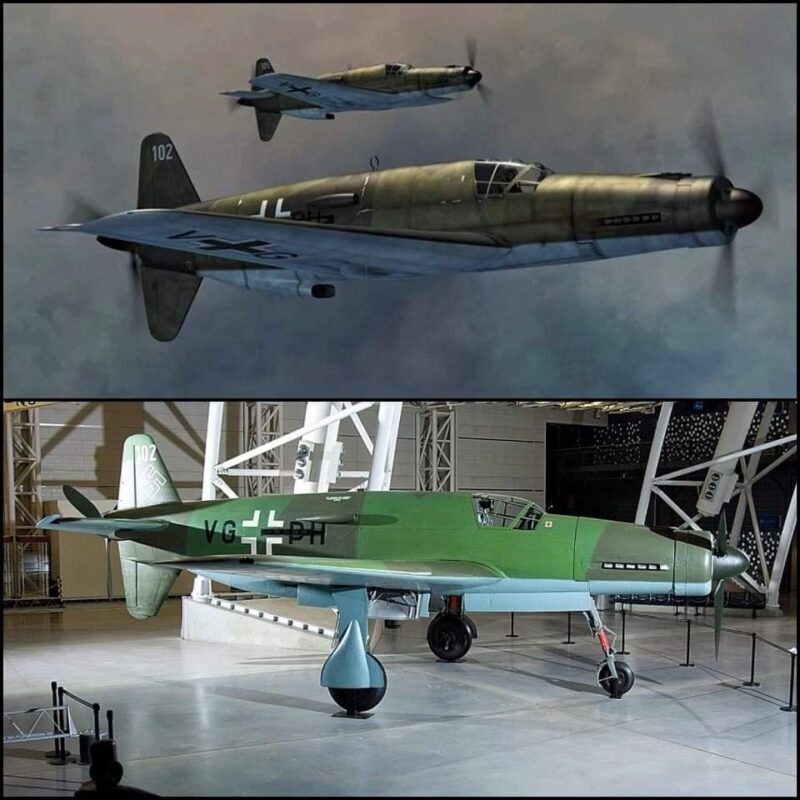
In 1937, Dornier received a basic patent on an aircraft, with two engines installed in the fuselage, each of which was intended to power a tractor and pusher propeller. After a few pilot aircraft (Göppingen Go 9 as a trial aircraft in 1939-40 and Do 231 fighter-bomber in 1941), the radical Do 335 was developed as a response to a specification requirement of the German Luftwaffe in 1942, which demanded an attack/intruder aircraft.
Later, the specification was also extended to fighter and night-fighters, fighter-bomber and reconnaissance aircraft, which led to a delay in the development process for the first time as early as 1943.
Performance of the Do 335
The Do 335 V1 flew for the first time in Oberpfaffenhofen on October 26, 1943, with a 1.800-hp DB603E engine in the nose and another in the rear fuselage section, which powered the pusher propeller.
Then, the Do 335 official tests were carried out in Rechlin and, except for low stability problems due to the length of the aircraft, the reports of the test pilots were mostly positive. In particular the speed, acceleration, turning circle and the good handling of the aircraft surprised most pilots. Thus, the development proceeded quickly and without major concerns.
Although heavy, the Do 335 was powerful and very fast and, for understandable reasons, was the first aircraft to have a standard ejector seat.
Production and chaos
Up to the end of the war only 36 or 37 Do 335 could be finished. These included 13 pilot aircraft in the prototype status, 10 pre-production planes of the A-0, 11 A-1 and two A-12 double-seat training aircraft.
Another 70 to 80 Do 335 arrows were in the final production and were waiting for components.
To the difficulties caused by the critical war as well the transport situation there were still constant changes to the priorities for the aircraft.
In November 1943 it was decided to build a fast bomber to attack British cities or ground troops instead of a heavy fighter. In January 1944 a reconnaissance aircraft was called for (since the conventional recon aircraft could no longer bring enlightenment results to the imminent invasion from Britain), in March 1944 the heavy fighter again to ward off the US day bomber attacks.
Three months later, the Do 335 A-1 and A-2 were finally delivered as bomber aircraft. In August 1944 the night-fighter was given the highest priority, on September 26 the heavy fighter again. On October 10 the night-fighter was again desired, of which the first prototype was available on November 15.
Operations
The first armed prototype was the V5, while the V9 was the prototype for the A series and armed with two 15-mm-MG151/15 in the upper fuselage and a 30-mm-MK103 cannon firing through the front spinner.
The first pre-production machine, the Do 335 A-0 followed shortly after mid-1944 and the Erprobungskommando 335 (Trial command 335) was set up in the following September with the first 10 A-0.
In late autumn 1944, the production model Do 335 A-1 appeared from the factory site in Oberpfaffenhofen with the final DB 603E-1 engine. The Do 335 A-1 could carry a 500 kg or two 250 kg bombs internal.
No Do 335 saw regular combat missions, even if some A-0 from autumn 1944 from the Erprobungskommando 335 also had to be used in airspace where contact with enemy planes could be happened. Several Allied pilots reported the sighting of the odd-looking plane.
The Allied fighter’ ace’ Pierre meet with the Do 335 Arrow in April 1945. He talks about it, that he was flying in a bunch with 4 Hawker Tempest fighters when he saw a single Do 335 traveling at maximum speed at low-level above the trees. Regardless of his fighter’s great speed at low altitudes, they were unable to intercept or even come close to fire on the Arrow.
Other prototypes
There were prototypes for several other versions, including the Do 335 A-4 (a A-0 converted for unarmed photo-recon), A-6 (V10 as tandem two-seat night fighter), A-10 and A-12 (V11 and V12 as two-seat trainer) as well as B-1 and B-2 (V13 or V14) as heavy destroyers.
Incomplete prototypes existed, among others, for the Do 435 night-fighter (V4), where the crew should sit side by side in the fuselage and which should receive 2,500-hp Jumo 222 engines.
For this, the prototypes V15 to V20 for the B-1, B-2 and B-3 destroyers and the B-6 and B-7 night-fighters.
The B-4 and B-8 should be high-altitude fighters with increased wing span and the B-5 the corresponding trainer.
The Do 635 (later renamed Ju 8-635) was a project for a reconnaissance aircraft with over 4,000 miles (ca. 6,437 km) range.
Some Do 335 Arrows were still completed until 1947 for the Allies for experimental purposes.
Probably the night-fighter version of the Do 335 Pfeil would have become the model with the best combat results.
At the end of 1944, the new Focke-Wulf Ta 152 was prefered as a fighter plane from the Luftwaffe instead of the Do 335. Although the Do 335 was promising as a fighter with an outstanding performance in May 1944, a year later, its advantages compared to the current Allied fighter planes had clearly diminished. As a day fighter, the Do 335 would still have a slightly higher speed than the Ta 152, but was no better at range or flight time. For this the fuel consumption of the Do 335 was much larger and production and repair costs were also much more expensive.
Users: Germany (Luftwaffe).
Animated 3D model Dornier 335 Arrow
Specifications Dornier Do 335 A-1 Pfeil (Arrow)
Specifications:
Do 335 A-1 | Specification |
|---|---|
Type | fighter-bomber |
Power plant | Two 1,900 hp Daimler-Benz DB 603G 12-cylinder inverted-vee liquid-cooled engines, in push/pull arrangement |
Accommodation | 1 |
Wing span | 45 ft 4 in |
Length overall | 45 ft 6 in |
Height overall | 16 ft 4 in |
Wing area (A-0) | 414.41 sq/ft |
Weight empty | 16,314 lb |
Weight maximum loaded | 25,800 lb |
Max. wing loading (A-0) | 50.59 lb/sq ft |
Max. power loading (A-0) | 5.99 lb/hp |
Maximum speed | 477 mph (455 mph at 23,295 ft for A-0) |
Cruising speed | 413 mph (393 mph at 18,700 ft for A-0) |
Initial climb | 4,600 ft/min |
Time to 26,245 ft "14.5 min " | |
Service ceiling | 37,400 ft (31,170 ft for A-0) |
Range | 1,280 miles (2,330 miles with drop tank) |
Armament:
Do 335 A-1 | Specification |
|---|---|
through front propeller hub | One 30mm MK103 (420 rpm; velocity 2,820 ft/sec) |
above nose | Two 15mm MG151/15 (700 rpm; velocity 3,131 ft/sec) |
Service statistics:
Video from the action with Do 335 ‘Arrow’ in video games
Mission with Jagdpanther and Do 335 B-2 (from minute 2:45) in a ‘Realistic Ground Battle’ of the free2play game War Thunder:
Who does not know the F2P tank and plane war game War Thunder can download it from here for free:
References and literature
Combat Aircraft of World War II (Bill Gunston)
Technik und Einsatz der Kampfflugzeuge vom 1. Weltkrieg bis heute (Ian Parsons)
Das große Buch der Luftkämpfe (Ian Parsons)
Luftkrieg (Piekalkiewicz)
Flugzeuge des 2. Weltkrieges (Andrew Kershaw)
German Aircraft of World War 2 in Colour (Kenneth Munson)
Warplanes of the Luftwaffe (David Donald)
The Luftwaffe Album, Bomber and Fighter Aircraft of the German Air Force 1933-1945 (Joachim Dressel, Manfred Griehl)




